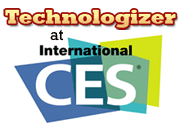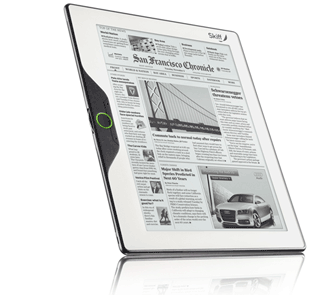 It sounds…well, not too good to be true, but pretty darn neat, at least in theory. The New York Times’ Brad Stone is reporting that most of the big Hollywood studios and a bunch of major tech companies are planning to use this week’s Consumer Electronics Show in Las Vegas to unveil the Digital Entertainment Content Ecosystem, a plan to let folks who buy a movie or TV show in one format, and then get easy access to it in other formats on other devices.
It sounds…well, not too good to be true, but pretty darn neat, at least in theory. The New York Times’ Brad Stone is reporting that most of the big Hollywood studios and a bunch of major tech companies are planning to use this week’s Consumer Electronics Show in Las Vegas to unveil the Digital Entertainment Content Ecosystem, a plan to let folks who buy a movie or TV show in one format, and then get easy access to it in other formats on other devices.
End result: If you buy the Blu-Ray of Jaws, you might also get the right to watch it on your Internet TV box, or download it to a media player, courtesy of a digital “locker” in the sky that keeps track of what you’ve paid for. What you wouldn’t have to do is hand over full price to Hollywood each time you want to get a movie for a new gizmo.
When I think of the hassle and expense of re-repurchasing video in new forms, I always come back to the fact that I’ve bought Pinocchio from Disney so many times over the past quarter century that I’ve lost track–as a VHS tape, as a DVD (more than once, in multiple remasterings), on Blu-Ray, and as an iTunes download. DECE isn’t going to let me stop buying this particular movie, for the simple reason that Disney is the only Hollywood biggie that isn’t on board. As Stone says, it’s supporting a similar system called KeyChest. Rumor has it that it could roll out that digital locker in collaboration with Apple, which also isn’t on the DECE team.
As I’ve said many times, I’m not opposed to copy protection on religious grounds–it’s just that nearly every implementation of it devised to date has been either a minor hassle or a major one, with no benefit to those of us who pay for our content. DECE and/or KeyChest could make copy protection far more palatable–I’d be much more inclined to plunk down money for a Blu-Ray if what I was buying was not a physical shiny disc but the right to watch that movie where I pleased, on the device of my choice. And no, copies of movies that aren’t locked up with copy protection at all don’t accomplish the same thing–they’re in one format that’s not compatible with every gizmo, and they’re too humongous to shuffle around between all your devices without a lot of effort.
I’m not giddy over any of this yet–a lot of details remain unknown. Is Warner Bros. really willing to sell me a movie one last time, then give me access to it in a multitude of formats for the next few decades, or can it use DECE to parcel out access in a parsimonious fashion that’s not that exciting? Will pervasive Internet access render DECE unnecessary by providing a streaming version of movies that works perfectly on gadgets of all sorts? What happens if DECE isn’t as successful as its backers hope? (I’m instinctively skeptical of anything that involves using servers to unlock access to content–when the companies maintaining those servers lose interest, they have a tendency to shut them down and thereby cut off stuff that consumers thought they’d “bought.”)
All in all, though, I’m glad the entertainment industry is trying this. It’s surely better than doing very little to give movie fans an incentive to invest in new, legal copies of content they already own, which has usually been the industry’s strategy so far…
 It’s my first ever Consumer Electronics Show, so I was happy to see at least one completely ridiculous tech product upon arrival in Las Vegas. Creating a spectacle at the entrance to Tuesday night’s media event was the AR.Drone, a UFO-like toy that’s controlled by iPhone.
It’s my first ever Consumer Electronics Show, so I was happy to see at least one completely ridiculous tech product upon arrival in Las Vegas. Creating a spectacle at the entrance to Tuesday night’s media event was the AR.Drone, a UFO-like toy that’s controlled by iPhone.


 Among the gazillion products making their debut this week at the Consumer Electronics Show:
Among the gazillion products making their debut this week at the Consumer Electronics Show:  This seems to be the last evening we can ruminate on Google’s Nexus One phone without knowing everything there is to know about it. So I asked my Twitter pals “Do you think Google should get into the phone biz? Why or why not?” Read their thoughts, then add your own–and please
This seems to be the last evening we can ruminate on Google’s Nexus One phone without knowing everything there is to know about it. So I asked my Twitter pals “Do you think Google should get into the phone biz? Why or why not?” Read their thoughts, then add your own–and please It sounds…well, not too good to be true, but pretty darn neat, at least in theory. The New York Times’ Brad Stone is reporting that most of the big Hollywood studios and a bunch of major tech companies are planning to use this week’s Consumer Electronics Show in Las Vegas to unveil the
It sounds…well, not too good to be true, but pretty darn neat, at least in theory. The New York Times’ Brad Stone is reporting that most of the big Hollywood studios and a bunch of major tech companies are planning to use this week’s Consumer Electronics Show in Las Vegas to unveil the